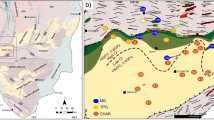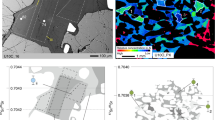Abstract
Giant uranium deposits were formed during the Mesoproterozoic era, 1.6–1.0 Gyr ago, in both Canada and Australia. The deposits are thought to have formed from large-scale circulation of brines at temperatures of 120–200 °C that percolated between sedimentary basins and underlying crystalline basement rocks1,2,3. However, the precise conditions for transport of the uranium in these brines are poorly understood4,5,6,7. Here we use mass spectrometry to analyse the uranium content of brines preserved in naturally occurring fluid inclusions in ore deposits from the Athabasca Basin, Canada. We measure concentrations of uranium in the range 1.0×10−6–2.8×10−3 mol l−1. These concentrations are three orders of magnitude above any other common crustal fluids. Experimentally, we measure the solubility of uranium as a function of NaCl content and pH, in mixtures that are analogous to ore-forming brines at 155 °C. To account for the high uranium content observed in the Athabasca deposits, we find that the brines must have been acidic, with a pH between 2.5 and 4.5. Our results strongly suggest that the world’s richest uranium deposits formed from highly concentrated uranium-bearing acidic brines. We conclude that these conditions are a necessary requirement for the formation of giant uranium deposits in relatively short periods of time of about 0.1–1 Myr, similar to other world-class deposits of lead–zinc and gold8,9.
This is a preview of subscription content, access via your institution
Access options
Subscribe to this journal
Receive 12 print issues and online access
$259.00 per year
only $21.58 per issue
Buy this article
- Purchase on Springer Link
- Instant access to full article PDF
Prices may be subject to local taxes which are calculated during checkout




Similar content being viewed by others
References
Kyser, T. K. & Cuney, M. in Recent and Not-so-Recent Developments in Uranium Deposits and Implications for Exploration (eds Cuney, M. &Kyser, T. K.) 161–219 (Mineralogical Association of Canada, 2008).
Boiron, M. C., Cathelineau, M. & Richard, A. Fluid flows and metal deposition near basement/cover unconformity: Lessons and analogies from Pb–Zn–F–Ba systems for the understanding of Proterozoic U deposits. Geofluids 10, 270–292 (2010).
Morichon, E., Beaufort, D., Allard, T. & Quirt, D. Tracing past migrations of uranium in Paleoproterozoic basins: New insights from radiation-induced defects in clay minerals. Geology 38, 983–986 (2010).
Raffensperger, J. P. & Garven, G. The formation of unconformity-type uranium ore deposits 2. Coupled hydrochemical modeling. Am. J. Sci. 295, 639–696 (1995).
Komninou, A. & Sverjensky, D. A. Geochemical modeling on the formation of an unconformity-type uranium deposit. Econ. Geol. 91, 590–606 (1996).
Kister, P., Vieillard, P., Cuney, M., Quirt, D. & Laverret, E. Thermodynamic constraints on the mineralogical and fluid composition evolution in a clastic sedimentary basin: The Athabasca Basin (Saskatchewan, Canada). Eur. J. Mineral. 17, 325–342 (2005).
Richard, A. et al. Brine–rock interaction in the Athabasca basement (McArthur River U deposit, Canada): Consequences for fluid chemistry and uranium uptake. Terra Nova 22, 303–308 (2010).
Simmons, S. F. & Brown, K. L. Gold in magmatic hydrothermal solutions and the rapid formation of a giant ore deposit. Science 314, 288–291 (2006).
Wilkinson, J. J., Stoffell, B., Wilkinson, C. C., Jeffries, T. E. & Appold, M. S. Anomalously metal-rich fluids form hydrothermal ore deposits. Science 323, 764–767 (2009).
Yardley, B. W. D. Metal concentration in crustal fluids and their relationships to ore formation. Econ. Geol. 100, 613–632 (2005).
Audétat, A., Günther, D. & Heinrich, C. A. Formation of a magmatic-hydrothermal ore deposit: Insights with LA–ICP–MS analysis of fluid inclusions. Science 279, 2091–2094 (1998).
Loucks, R. R. & Mavrogenes, J. A. Gold solubility in supercritical hydrothermal brines measured in synthetic fluid inclusions. Science 284, 2159–2163 (1999).
Ulrich, T., Günther, D. & Heinrich, C. A. Gold concentrations of magmatic brines and the metal budget of porphyry copper deposits. Nature 399, 676–679 (1999).
Pokrovski, G. S. & Dubrovinsky, L. S. The S3− ion is stable in geological fluids at elevated temperatures and pressures. Science 331, 1052–2054 (2011).
Cuney, M. Evolution of uranium fractionation processes through time: Driving the secular variation of uranium deposit types. Econ. Geol. 105, 553–569 (2010).
Kotzer, T. G. & Kyser, T. K. Petrogenesis of the Proterozoic Athabasca Basin, northern Saskatchewan, Canada, and its relation to diagenesis, hydrothermal uranium mineralization and paleohydrogeology. Chem. Geol. 120, 45–89 (1995).
Derome, D. et al. Mixing of sodic and calcic brines and uranium deposition at McArthur River, Saskatchewan, Canada: A Raman and laser-induced breakdown spectroscopic study of fluid inclusions. Econ. Geol. 100, 1529–1545 (2005).
Richard, A. et al. An evaporated seawater origin for the ore-forming brines in unconformity-related uranium deposits (Athabasca Basin, Canada): Cl/Br and δ37Cl study of fluid inclusions. Geochim. Cosmochim. Acta 75, 2792–2810 (2011).
Hecht, L. & Cuney, M. Hydrothermal alteration of monazite in the Precambrian crystalline basement of the Athabasca Basin (Saskatchewan, Canada): Implication for the formation of unconformity-related uranium deposits. Miner. Deposita 35, 791–795 (2000).
Mercadier, J., Richard, A., Boiron, M. C., Cathelineau, M. & Cuney, M. Migration of brines in the basement rocks of the Athabasca Basin through microfracture networks (P-Patch U deposit, Canada). Lithos 115, 121–136 (2010).
Hoeve, J. & Quirt, D. A stationary redox front as a critical factor in the formation of high-grade, unconformity-type uranium ores in the Athabasca Basin, Saskatchewan, Canada. Bull. Mineral. 110, 151–171 (1987).
Grenthe, I. et al. Chemical Thermodynamics of Uranium (Nuclear Energy Agency, 1992).
Guillaumont, R. et al. Update on the Chemical Thermodynamics of U, Np, Pu, Am and Tc (Nuclear Energy Agency, 2003).
Heinrich, C. A. et al. Quantitative multi-element analysis of minerals, fluid and melt inclusions by laser-ablation inductively-coupled-plasma mass-spectrometry. Geochim. Cosmochim. Acta 67, 3473–3497 (2003).
Allan, M. M. et al. Validation of LA–ICP–MS fluid inclusion analysis with synthetic fluid inclusions. Am. Mineral. 90, 1767–1775 (2005).
Pitzer, K. S. & Li, Y. G. Thermodynamics of aqueous sodium chloride to 823 K and 1 kilobar (100 MPa). Proc. Natl Acad. Sci. USA 80, 7689–7693 (1983).
Anderson, G. M. & Crerar, D. A. Thermodynamics in Geochemistry: The Equilibrium Model (Oxford Univ. Press, 1993).
Yates, D. M. & Rosenberg, P. E. Formation and stability of endmember illite: I. Solution equilibration experiments at 100–250 °C and Pv,soln . Geochim. Cosmochim. Acta 60, 1873–1883 (1996).
Benison, K. C., Goldstein, R. H., Wopenka, B., Burruss, R. C. & Pasteris, J. D. Extremely acid Permian lakes and ground waters in North America. Nature 392, 911–914 (1998).
Bali, E., Audétat, A. & Keppler, H. The mobility of U and Th in subduction zone fluids: An indicator of oxygen fugacity and salinity. Contrib. Mineral. Petrol. 161, 597–613 (2011).
Longerich, H. P., Jackson, S. E. & Günther, D. J. Laser ablation inductively coupled plasma mass spectrometric transient signal data acquisition and analyte concentration calculation. Anal. At. Spectrom. 11, 899–904 (1996).
Guillong, M., Meier, D. L., Allan, M. M., Heinrich, C. A. & Yardley, B. W. D. in Laser Ablation ICP–MS in the Earth Sciences: Current Practices and Outstanding Issues (ed. Sylvestor, P.) 328–333 (Mineralogical Association of Canada, 2008).
Lodding, W. & Ojamaa, L. Dehydration and thermal decomposition of uranyl nitrates in the presence of steam. J. Inorg. Nucl. Chem. 27, 1261–1268 (1965).
Acknowledgements
We thank Centre national de la recherche scientifique and Areva NC for financial support; Areva NC and Cameco for sampling and scientific collaboration; J. Cortot for ICP–atomic emission spectroscopy analyses; J. Grausem for the access to the Raman spectrometer; J. Dubessy, J. L. Vigneresse and B. W. D. Yardley for discussions and T. Pettke for help on early LA–ICP–MS work.
Author information
Authors and Affiliations
Contributions
M. Cuney, M. Cathelineau and M-C.B. conceived the project. J.M., M. Cathelineau and M. Cuney collected samples used in this study. A.R., M-C.B. and J.M. did the petrographic and microthermometric analyses of fluid inclusions. D.A.B., A.R. and M-C.B. carried out the LA–ICP–MS analyses of fluid inclusions. C.R. did the experimental U solubility measurements and analyses. A.R. and C.R. wrote the manuscript with contributions from all co-authors. All co-authors contributed to the discussion and interpretation of the data.
Corresponding authors
Ethics declarations
Competing interests
The authors declare no competing financial interests.
Supplementary information
Supplementary Information
Supplementary Information (PDF 577 kb)
Rights and permissions
About this article
Cite this article
Richard, A., Rozsypal, C., Mercadier, J. et al. Giant uranium deposits formed from exceptionally uranium-rich acidic brines. Nature Geosci 5, 142–146 (2012). https://doi.org/10.1038/ngeo1338
Received:
Accepted:
Published:
Issue Date:
DOI: https://doi.org/10.1038/ngeo1338
This article is cited by
-
Spatial variations in fluid composition along structures hosting unconformity-related uranium deposits in the Athabasca Basin, Canada: implications for ore-controlling factors
Mineralium Deposita (2023)
-
Mass Transfer during Hematitization and Implications for Uranium Mineralization in the Zoujiashan Deposit, Xiangshan Volcanic Basin
Journal of Earth Science (2022)
-
Classification of Sandstone-Related Uranium Deposits
Journal of Earth Science (2022)
-
Uranium carbonate complexes demonstrate drastic decrease in stability at elevated temperatures
Communications Chemistry (2021)
-
Hydrothermal activity in the basement granite associated with the unconformity-related uranium deposit in Chitrial area, Cuddapah Basin, India
Journal of Earth System Science (2021)



